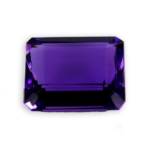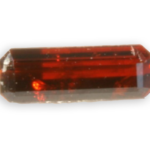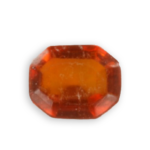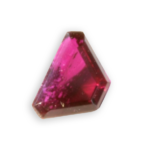
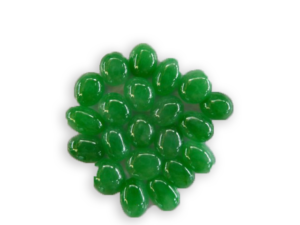
jade
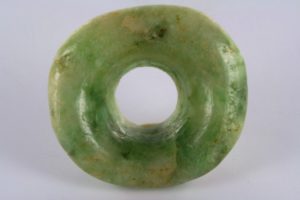
maya earrings from Guatemala
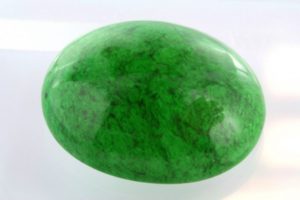
jade variety maw-sit-sit from Burma
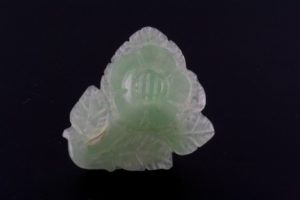
cut nephrite jade from China
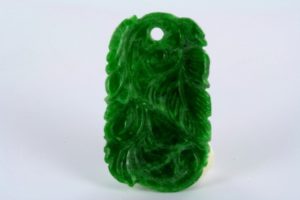
cut jade jadeite froml Burma
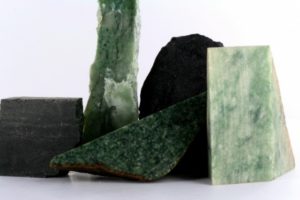
jade jadeite from Guatemala
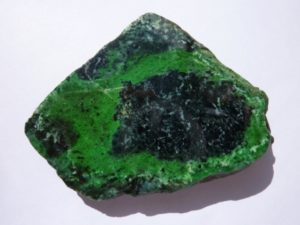
sliced maw-sit-sit jade from Burma
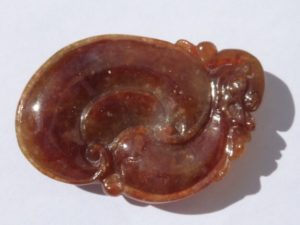
cut brown jade from Burma
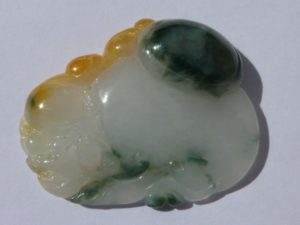
different colors of jade from Burma
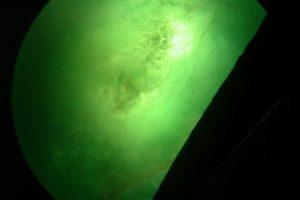
solid like inclusions in an imperial jade
Detailed sheet
jade
In the nineteenth century, it was shown that the so-called “jade” actually consisted of two distinct minerals:
The “Jadeite”, of the pyroxene family, is the hardest and most rare, it has a crystalline sound, its color varies from white to dark green, even lavender. The imperial jade is emerald green jadeite.
The “nephritis”, greasy luster, spinach-green to white color (known as “mutton fat”), consists of a calcic amphibole ranking between tremolite and actinolite and has a refractive index and density lower than jadeite.
These two stones are used in gemology, under the single term “jade”.
The “magnetite-jade” is the trade name for a black jade with magnetite inclusions.
The Chloromelanite is the name of a dark green jade with black veins rich in kosmochlor chromite.
The Maw-sit-sit that was discovered in 1963 by Gubelin in Burma in the same deposits as the imperial jade, in north-western Burma, is actually a mixture of several minerals, a rock, such as jadeite with chromite, ureyite, symplektite, kosmochlor and natrolite and its white veins consist of albite.
The name comes from the Mayan jade ” Yash “meaning green, or the Spanish” piedra de hijada “or Portuguese” pedra of ijada “, the :” stone of the side “, because it was reputed to cure colics.
The Neolithic men made arms and polished objects with it, nephritis being named “ax stone”.
The Chinese carved jade (nephrite), the celestial stone, for over 2000 years BC. The Olmecs and the Mayas vowed a great reverence for jade symbolizing eternity, immortality … They made bracelets, rings, pendants, earrings, necklaces, statuettes offered to the gods.
After 1850, we searched the deposits that they exploited, and it seems agreed that there was only a really important one, that of the Rio Motagua. Marco Polo, after his travels to the court the Mongol emperor Kublai Khan (XIV century), reported in Western Europe the existence of jade. Despite the prohibitions, the Portuguese were the first to import nephritis from China in the sixteenth century. The Spaniards then brought jadeite from South America.
Throughout Asia, jade is a symbol of luck and health, it is offered for all occasions: births, weddings, birthdays, graduation and even to sign professional contracts.

CHEMICAL CHARACTERISTICS
jadéite : NaAl[Si2O6], néphrite : Ca2(Mg,Fe)5[Si4O11]2 (OH)2
aluminum and sodium silicate for jadeite and magnesium calcium and iron silicate, for nephritis

PHYSICAL CHARACTERISTICS
Main color
green
Other colors
white, brown, yellow, black, orange, pink, purple
often different shades of mixed colors
Color of streak
white
Luster
greasy
Hardness
6.0 to 7.0
Density
2.90 to 3.40
Cleavage
none
Fracture
splintery, uneven

OPTICAL PROPERTIES
Transparency
opaque, translucent
Refractive index
1.600 - 1.660
Double refraction
0.013
definite biaxial positive for jadeite. But biaxial negative for nephritis
visible double refraction
No
Pleochroism
absent
Number of colors
1
Absorption spectrum
691 - 437
691 and 437 for jadeite and 589 for nephrite 509 difficult to observe

light green jadeite spectrum system

dark green jadeite spectrum system
Fluorescence
variable
only jadeite may be slightly greenish white flurorescente
Inclusions
possible metallic inclusions for nephrite

CRYSTALS PROPERTIES
nephritis is a tangle of fibers of monocrystalline actinolite hence its high toughness.
crystals system
monoclinic
massive microcrystalline aggregates

OTHER INFORMATIONS
Astrological sign
Capricorn, Gemini, Leo, Libra
Chinese astrological sign
Dog, Dragon, Horse, Monkey, Ox, Pig, Rabbit, Rat, Rooster, Sheep, Snake, Tiger

APPROACHING GEMS
Exploited
sites
There are a dozen deposits of jadeite in the world, the largest being located in northern Burma.
Then there is Sierra de Las Minas, in the valley of the Motogua in Guatemala, where pre-Columbian civilizations found theirs. Forgotten, this deposit was rediscovered in 1973. The alluvial deposit is only been known for ten years while it delivers a beautiful translucent jade, blue to green colored.
We can then include Japan (Omi-gawa and Kotaki-gawa area Niigata), Kazakhstan, Russia (Ketchpel in the Polar Urals in chains Borus in Western Sayan), the United States (veins of serpentine New Idria, California), Italy ( Punta Rasciassa, in the Monviso serpentine, in the western Alps ).
With regard to nephritis, the deposits are more numerous, the oldest being located in New Zealand in the South Island, called Jade island, where she has always been popular with the Maoris, China (region of Khotan, of Kashgar. In the nineteenth century, Karl Faberge has very much used a translucent nephritis with black inclusions coming from Russia. Other deposits are located in Canada (British Columbia, which produces 85% of world production and selling to China), Australia (Tasmania, Cowel), Brazil, United States (Wyoming, Alaska, California, south of Carmel), New Guinea, Mexico, Russia (near Lake Baikal in Siberia, the production being exported to China), Taiwan, Zimbabwe …
use in jewelry
The jade used to make cabochons, necklaces, bracelets, pendants, many jewels, vases, bowls, ornament and worship objects. It is in Hong Kong and Taiwan that the jade is mainly worked to be exported worldwide.
In China, the emperor, at the annual festival during which, he was “leaving the world,” ascended a disc of spinach-green nephrite about 60 centimeters in diameter, disc that was sold in Paris in 1932. The jade was practically reserved for the imperial family in China, it symbolized eternity, they used to slip a bit in the mouth of the deceased.
The jadeite, or “imperial jade”, emerald green, translucent on the edges, is the most popular.
The maw-sit-sit, which is not really jade, but a rock-based chromian jadeite, is used in jewelry as cabochons or faceted stones.
Jade is the stone of the 12th anniversary or the 26th year of marriage.
Daily care
and precautions
Do not expose to heat or solvents, because some jades are artificially colored. Jadeite is sensitive to sudden shocks and may break, Nephritis is much stronger, somewhat fragile and of very easy maintenance. Jewelers take care not to expose them to the torch flame only just to see it turning white.
imitations and
treatments
It is imitated with lead glass (well known to the Chinese), colored glass, with plastic, porcelain, enamel … doublets, triplets made of jade, dyed quartzite, jade enhanced by artificial dyes.
It should be noted that in the Far East, the jades bleached, dyed and laminated are common in trade. We have synthesized jade plates.
The African solid grossular is called “Transvaal jade” but the name is illegal.
Historical
healing properties
In China, Confucius had seen the five great virtues of jade: justice, charity, wisdom, courage, purity, and that’s probably why it was preferred among all the other stones in this country.
It is a matter who has a great price because of its role and ritual magic, earthly incarnation of cosmic Yang principle since at least 4000 BC. The emperor had to absorb some during periods of purification. All of the ritual objects were made of jade and we have very detailed descriptions.
The “pi”, a disk pierced in the middle symbolizes the sky and the hole the center from which all influences emanated.
Jade was also used as an amulet in the funeral rites, supposed to prevent putrefaction of corpses (a “pi” was placed under the body). Jade, in the broadest sense, symbolizes righteousness, strength, predisposing to calm, tolerance, harmony, peace, ensure honesty, temperance, tolerance. It would boost our emotional development,enhance relaxation, providing a feeling of satisfaction. It would extend life.
Jade has been described as supposed to calm the renal colics (hence the name of nephritis), act on the kidney stones and all the affection of the urinary tract … it had to be put on the painful area and degrease all quarters with calcined bones powder. Admittedly, both among the Chinese (who drank a pint, crushed and dissolved, mixed with the juice of herbs) than among Native Americans, it was renowned for its healing powers and the Emperor Rudolf II of Habsburg bought a piece for 1600 crowns. It was, at that time, considered fighting against gout, sciatica, epilepsy, poisonous bites.
historical stones
and related legends
According to the legend, the last Aztec emperor, Montezuma II, was pleased in 1521 that “those devils of Spaniards who plundered all the gold that made them crazy”, were not interested in jade, the essential, according to him. This sacred stone of the South Americans came from a more southern region, the Sierra de las Minas, in the current Guatemala, and then populated by the Maya. Indeed, the invaders did not consider valuable anything but gold and silver, saying that those who wore jade were idolaters who were tortured by the fanatics from Europe.
The most famous piece is a dark green mask from Tikal dating from the first century BC.
According to the Chinese alchemist of the fourth century, Koh Hung, “the jade dough forms in the mountains that contain this mineral. It is found only in steep and dangerous places. Jade juice flowing from these mountains coagulates into a paste after periods of some ten thousand years. It is fresh and crystal clear “.
Venez visitez
notre site web
voillot-joaillier.fr
Lorem ipsum dolor sit amet, consectetur adipiscing elit. Ut elit tellus, luctus nec ullamcorper mattis, pulvinar dapibus leo.Lorem ipsum dolor sit amet, consectetur adipiscing elit. Ut elit tellus, luctus nec ullamcorper mattis, pulvinar dapibus leo consectetur adipiscing elit. Ut elit tellus, luctus nec.

